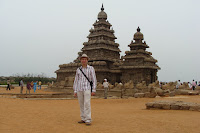The first monuments we visited were the five Rathas, so named because they are in the form of chariots. They are considered models of temples and each was carved out of a single block of granite.




In the photo below I am standing next to a sculpture of Ardhanari, the hermaphroditic representation of Shiva and his consort Shakti, symbolizing the union of male and female in the divine.

We also visited some of the fourteen ancient mantapams, or shrines located in the town. These were carved out of the solid rock hill that dominates the landscape. Some are unfinished.



The bas relief below is from one of the mantapams. It depicts a battle between Durga, "one who can redeem in situations of utmost distress" and Mahishasur, an asura (demon) who was invincible even to the gods.

The gods, angered by Mahishasur and their inability to defeat him, emitted beams of fierce light and Durga emerged at their convergence. However, she is not considered to be created by the gods, but to be dependent on the universe itself and not to any particular being or thing in it. Durga is depicted as brilliantly radiant, with several arms, each holding a different weapon, and riding a lion. In their first encounter, Mahishasur doubted Durga's powers until she laughed so powerfully that she caused an earthquake. They engaged in battle, with Mahishasur changing form several times, until once, mid-way through one of his transformations, Durga paralyzed him with the blinding light she emanated. She then let out a resounding laugh before cutting off his head.
I don't have a story to go with the bas relief below; I just like it.

The most famous bas relief in Mahabalipuram, and possibly India, is known as "Arjuna's Penance" or the "Descent of the Ganges". It is 96 feet long and 43 feet high.

In one interpretation, the work is about Arjuna, who performed a penance in order to receive from Shiva a powerful weapon that he could then use in battle. Arjuna is depicted below performing the penance.

In another interpretation, the figure above is not Arjuna, but Bhagiratha, who performed a penance to allow the Ganges river to flow over the ashes of his relatives and release them from their sins. There is a cleft in the rock over which water may have flowed at one time, and figures in it are thought to represent the Ganges

In another part of the work, one sees a cat, performing a similar penance! The cat is surrounded by mice or rats. The original meaning may be lost, but the effect today is comic.

The tradition and skill of stone carving is still very much alive in Mahabalipuram. Several artists are busy at work in the town, sculpting works that range in size from jewelry to monuments.

The red mound of earth you see below is an anthill or termite nest. Snakes sometimes move into them, and this one has holes through which snakes can pass. In Hindu belief, snake gods are associated with health and wealth. If you click on the photo to enlarge it, you will see a small round vessel on the rock in front of the hill, where the faithful may leave an offering for the snakes, such as eggs and milk.

One of the unique geological features of the area is a huge round boulder known as the butter ball. It is perched on a hillside, and looks as if it could roll down at any moment, although it has been there since time immemorial.

Of course, there always has to be someone who tries to push it over!

The last monument we visited was the Shore Temple, overlooking the Bay of Bengal. It was constructed in the 8th century C.E. out of blocks of granite and is considered one of the oldest "built" temples in South India, rather than being cut out of rock.



People flock to the adjacent beach to enjoy the cool breezes from the ocean.

Large rocks have been added to part of the beach to protect the Shore Temple from erosion and tidal waves.

For an arial view of the town, plus 360 tours of some of the monuments, visit www.world-heritage-tour.org.
Post script August 16, 2009: India's NDTV television network had a series on the "7 Wonders of India", where they visited several remarkable places and invited viewers to vote on which should become the 7 wonders of India. They included a segment on Mahabalipuram.

No comments:
Post a Comment